![[Journée du XIII Vendémiaire, L'an IV. Eglise St. Roch, rue St. Honoré.]](img-thumbnail/jpegs/36163.jpg)
[Journée du XIII Vendémiaire, L'an IV. Eglise St. Roch, rue St. Honoré.]
Dessiné par C. Monnet. Gravé par Helman.
Engraving with large margins. Plate: 450 x 280mm (17¾ x 11"). Slight paper tone and surface dirt.
Depiction of the battle which took place between the Royalists and the French Revolutionary Troops on the 13 Vendémiaire Year 4 (5th October 1795), a battle which was to instigate Napoleon Bonaparte's rapid advancement. The Revolutions anti-catholic sentiments created strong anti-revolutionary feelings in western France, feelings which boiled over into an insurrection. The Royalists, supported by British troops, having been victorious in several battles marched on Paris. Royalists within the city began demonstrations which soon turned violent. A young General Bonaparte suceeded in defeating the Royalists, essentially extinguishing the threat to the Revolution, and was promoted to General of the Division.
[Ref: 36163] £160.00
(£192.00 incl.VAT)

Design of a painted Ceiling executed in the Room called the Japanned Room, in the Queen’s House. Plâfond peint, executé dans une Chambre nommée la Japonnaise, dans le Palais de la Reine. Plate VII.
R. Adam Architect 1762. B. Pastorini Sculp.
Published as the Act directs 1775.
Engraving with small margins. Plate 590 x 437mm. 23¼ x 17¼". Creasing.
Ceiling designs for the Japanese room in the Queen's Palace; Volume I, part 5, "Works in Architecture". Robert and his brother James Adam forever changed the face of British architecture by introducing innovative Classical design ideas. From 1754-57, Robert lived in Italy where he had a long productive friendship with Piranesi, which was inspirational for both men. Upon his return, the brothers launched their career by building the Adelphi from the Thames to the Strand in London, which although not a commercial success at the time, included one of London's most cherished buildings, the Adlephi Theatre. Together, the Adam brothers designed and built some of the most famous buildings in England, including such bastions of English architecture as Kenwood House, Keddlestone Manor, and Syon House. To the interiors of their English country houses, the Adams brought wonderful ornamental elements in niches, lunettes, festoons and reliefs. Their classically designed buildings were so numerous in London that they changed the prevailing feel of the city and established their brand of neo-Classicism as the model of elegance and importance. It is asserted that the brothers originated the concept of the uniform facade attached to the typical English row house, an architectural device that distinguishes London buildings. This monumental contribution is evidenced in the Adams' designs for Portland Place and Fitzroy Square, and these were used as architectural models for the whole city. The brothers brought their talents into other areas by designing furniture to complement their beautiful interiors and by creating and publishing a treatise of design entitled 'Works in Architecture'. The work was published in three volumes over an extended span of time, beginning in 1773, with the final volume being published posthumously in 1822.
[Ref: 27735] £260.00
(£312.00 incl.VAT)
![[Designs of different pieces of furniture done for this House.]](img-thumbnail/jpegs/27740.jpg)
[Designs of different pieces of furniture done for this House.] Plate VIII.
R. Adam Architect. B. Pastorini Sculp.
Published as the Act directs 1774.
Engraving with small margins. Plate 444 x 590mm. 17½ x 23¾".
Luton House with designs for the stove-grate, cornices for window-curtain, and brass candelabra designs; Volume I, part 3, "Works in Architecture". Robert and his brother James Adam forever changed the face of British architecture by introducing innovative Classical design ideas. From 1754-57, Robert lived in Italy where he had a long productive friendship with Piranesi, which was inspirational for both men. Upon his return, the brothers launched their career by building the Adelphi from the Thames to the Strand in London, which although not a commercial success at the time, included one of London's most cherished buildings, the Adlephi Theatre. Together, the Adam brothers designed and built some of the most famous buildings in England, including such bastions of English architecture as Kenwood House, Keddlestone Manor, and Syon House. To the interiors of their English country houses, the Adams brought wonderful ornamental elements in niches, lunettes, festoons and reliefs. Their classically designed buildings were so numerous in London that they changed the prevailing feel of the city and established their brand of neo-Classicism as the model of elegance and importance. It is asserted that the brothers originated the concept of the uniform facade attached to the typical English row house, an architectural device that distinguishes London buildings. This monumental contribution is evidenced in the Adams' designs for Portland Place and Fitzroy Square, and these were used as architectural models for the whole city. The brothers brought their talents into other areas by designing furniture to complement their beautiful interiors and by creating and publishing a treatise of design entitled 'Works in Architecture'. The work was published in three volumes over an extended span of time, beginning in 1773, with the final volume being published posthumously in 1822.
[Ref: 27740] £330.00
![[Various Clocks & Pieces of Ornamental Furniture.]](img-thumbnail/jpegs/27739.jpg)
[Various Clocks & Pieces of Ornamental Furniture.] Plate VIII.
R. Adam Architect. P. Begbie Sculp.
Published as the Act directs 1773.
Engraving with small margins. Plate 599 x 464mm. 23½ x18¼".
Various ornamental pieces designed and executed for different persons, including 3 clocks, a watch case, executed for Lady Aspley's dressing room; Volume I, part 4, "Works in Architecture". Robert and his brother James Adam forever changed the face of British architecture by introducing innovative Classical design ideas. From 1754-57, Robert lived in Italy where he had a long productive friendship with Piranesi, which was inspirational for both men. Upon his return, the brothers launched their career by building the Adelphi from the Thames to the Strand in London, which although not a commercial success at the time, included one of London's most cherished buildings, the Adlephi Theatre. Together, the Adam brothers designed and built some of the most famous buildings in England, including such bastions of English architecture as Kenwood House, Keddlestone Manor, and Syon House. To the interiors of their English country houses, the Adams brought wonderful ornamental elements in niches, lunettes, festoons and reliefs. Their classically designed buildings were so numerous in London that they changed the prevailing feel of the city and established their brand of neo-Classicism as the model of elegance and importance. It is asserted that the brothers originated the concept of the uniform facade attached to the typical English row house, an architectural device that distinguishes London buildings. This monumental contribution is evidenced in the Adams' designs for Portland Place and Fitzroy Square, and these were used as architectural models for the whole city. The brothers brought their talents into other areas by designing furniture to complement their beautiful interiors and by creating and publishing a treatise of design entitled 'Works in Architecture'. The work was published in three volumes over an extended span of time, beginning in 1773, with the final volume being published posthumously in 1822.
[Ref: 27739] £330.00
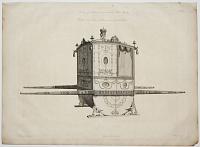
Design of a Sedan Chair as executed for Her Majesty. Dessein d’une Chaise à Porteur executée pour la Reine. Plate VI.
R. Adam Architect 1771. P. Begbie sculp.
Published as the Act directs 1773.
Engraving with small margins. Plate 444 x 591mm. 17½ x 23¼".
Design for a sedan chair; Volume I, part 5, "Works in Architecture". Robert and his brother James Adam forever changed the face of British architecture by introducing innovative Classical design ideas. From 1754-57, Robert lived in Italy where he had a long productive friendship with Piranesi, which was inspirational for both men. Upon his return, the brothers launched their career by building the Adelphi from the Thames to the Strand in London, which although not a commercial success at the time, included one of London's most cherished buildings, the Adlephi Theatre. Together, the Adam brothers designed and built some of the most famous buildings in England, including such bastions of English architecture as Kenwood House, Keddlestone Manor, and Syon House. To the interiors of their English country houses, the Adams brought wonderful ornamental elements in niches, lunettes, festoons and reliefs. Their classically designed buildings were so numerous in London that they changed the prevailing feel of the city and established their brand of neo-Classicism as the model of elegance and importance. It is asserted that the brothers originated the concept of the uniform facade attached to the typical English row house, an architectural device that distinguishes London buildings. This monumental contribution is evidenced in the Adams' designs for Portland Place and Fitzroy Square, and these were used as architectural models for the whole city. The brothers brought their talents into other areas by designing furniture to complement their beautiful interiors and by creating and publishing a treatise of design entitled 'Works in Architecture'. The work was published in three volumes over an extended span of time, beginning in 1773, with the final volume being published posthumously in 1822.
[Ref: 27736] £350.00
![[The Aeolinan]](img-thumbnail/jpegs/62245.jpg)
[The Aeolinan]
[n.d., c.1830.]
Scarce lithograph. Sheet 225 x 150mm (8¾ x 6"). Trimmed to printed border.
Portraits of a man and women playing the aeolian (an early harmonica, known as a 'Mundharmonika' in German), with examples of the instrument underneath. At the bottom is an example of an improved version, designed by Charles Wheatstone (1802-75) in 1827. Sir Charles Wheatstone also invented the English concertina, but his main fame comes from creating the stereoscope and involvement in early telegraphy.
[Ref: 62245] £260.00
(£312.00 incl.VAT)
![[Life of Aesop: Aesop convicting his fellow servants of having eaten the figs.]](img-thumbnail/jpegs/48708.jpg)
[Life of Aesop: Aesop convicting his fellow servants of having eaten the figs.] [So thrive false witnesses...]
[Etched by Thomas Dudley after Francis Barlow.]
[Amsterdam: Etiènne Roger, 1714.]
Etching. Sheet 205 x 165mm (8 x 6½") Trimmed within plate, mounted on album paper.
Aesop, having beeen accused of eating his master's figs, has vomited to show he had eaten nothing, then insists his accusers do the same, proving their guilt. Plate 1 of thirty-one illustrations added to the second edition of Barlow's "Æsop's Fables, With His Life" (1687), to illustrate the translation of Planudes's Life of Aesop, which was unillustrated in the first edition of 1666. This example comes from an Amsterdam edition, 'Les Fables d'Esope', with the printing plate trimmed down. All of the plates were designed by Barlow: they were etched c.1678-9, only five by Barlow; the rest, including this one, by Thomas Dudley. Originally the plate extended down with a title verse (possibly written by Aphra Behn, who wrote new verses for the fables), but for this non-English edition the verse was trimmed off and new borders engraved. Little is known of Dudley: on one plate of this series he signed himself as a student of Wenceslaus Hollar; and in 1679 he went to Lisbon, where he is known to have made further prints, and he is not supposed to have returned to England thereafter. He etched some portraits but these prints after Barlow are his most important work. BM: 1871,0812.235, described as a proof state.
[Ref: 48708] £95.00
(£114.00 incl.VAT)
![[The Satyr and the Peasant.] Iste frigus & ardorem [...]](img-thumbnail/jpegs/57441.jpg)
[The Satyr and the Peasant.] Iste frigus & ardorem [...]
J. Jordaens, pinxit. Vosterman scul:
Cum Privilegÿs Reg: [n.d., c.1621.]
Engraving. 415 x 405mm (16¼ x 15¾). Thread margins, repairs to left platemark.
A satyr chastises a peasant for blowing on his food, after he had blown on his hands to keep them warm. The satyr says ''I can no longer consider you as a friend, a fellow who with the same breath blows hot and cold". One of several paintings by Jacob Jordaens (1593-1678) based on one of Æsop's fables. According to the BM the original painting is in the Kunstmuseum in Göteborg, with another version in the Musées Royaux des Beaux-Arts, Brussels. BM 1873,1213.588.
[Ref: 57441] £320.00
(£384.00 incl.VAT)
![[The Satyr and the Peasant.]](img-thumbnail/jpegs/57789.jpg)
[The Satyr and the Peasant.]
Dutius 1764 [Etched by Christian Dietrich, after Cornelis Bega?].
Fine etching. 140 x 170mm (5½ x 6¾"). Narrow margins, mounted on album paper at corners.
A fine impression showing a satyr chastises a peasant for blowing on his food, after he had blown on his hands to keep them warm. The satyr says ''I can no longer consider you as a friend, a fellow who with the same breath blows hot and cold". Based on one of Æsop's fables. Linck 100.39.
[Ref: 57789] £360.00
(£432.00 incl.VAT)
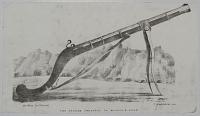
The Afghan Joozaeel or Mountain Rifle.
On Stone by J.Bennett. T. Black, Lith Cal. 1840.
Lithograph, rare. Sheet 115 x 205mm, 4½ x 8¼". Narrow margins.
A very unusual illustration of a jezail, with the distinctively curved stock and a bipod. It has been suggested that the jezail was originally designed to be held like a pistol with the stock under the arm, allowing use on horseback. However during the First Anglo-Afghan War (1839-42) it came into its own as a sniper weapon, fired down from high cliffs down onto the British Army retreating from Kabul to Jalalabad. Being heavier and longer-barrelled than the British Brown Bess musket, the Jezail outmatched the return fire. Most were hand-made: only a few were rifled.
[Ref: 27025] £65.00
(£78.00 incl.VAT)
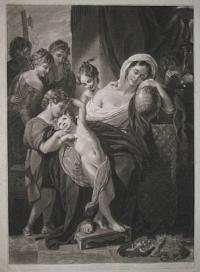
Agrippina, surrounded by her Children, weeping over the Ashes of Germannicus.
B. West R.A. pinxit, 1773, London. V. Green, Engraver in Mezzotinto to his Majesty Fecit. From the Original Picture in the Possession of A. Vesey.
Publish'd by J. Boydell, Cheapside July 23. 1774.
Mezzotint, very rare open letter title, 610 x 430mm. 24 x 17". Margin with tears, one just into plate at right.
The widow Agrippina, seated, mourns with her head resting against an urn inscribed with her husband Germanicus’s name, comforted by one of her daughters, who touches her neck. A naked boy stands at her feet, leaning back with his hand on his brother's head; behind two young women stand, their arms around each other. A young man beside them buries his head in his hands, another son at the left bows his head; a crown, laurels and a statue of an eagle in the right foreground. In 5 AD Agrippina married Germanicus, her second cousin and step-grandson of the Emperor Augustus. Agrippina had nine children by Germanicus, including the future emperor Gaius (Caligula). Agrippina was very popular among the Roman people, not least because of her marriage to the much-loved Germanicus, whose ashes she brought back to Rome after his death in the east in AD 21. Her strength and popularity aroused the suspicions of the emperor Tiberius and his right-hand man Sejanus, head of the Praetorian guards and she and her eldest son were banished to the Pontian islands on the Bay of Naples in AD 29. Four years later, following a beating so severe that she was blinded in one eye, Agrippina starved herself to death. Her popularity, however, ensured a decent burial, and she was laid to rest at Rome in the Mausoleum of Augustus.
After Benjamin West (1738 - 1820). Whitman: 180, II of II. Chaloner Smith: undescribed. Ex: Collection of The Hon. C. Lennox-Boyd.
[Ref: 14844] £360.00
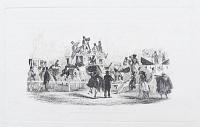
How to dine "Al Fesco."
E Landells [in image lower right]
London, Published Sept.r 1840, for the Proprietors of the Sporting Review, by R. ACkermann, 191 Regent St.
Etching, platemark 165 x 270mm (6½ x 10½").
Young gentlemen at a racing meet, arranging refreshments on their stagecoach. By Ebenezer Landells (1808-1860), illustrator and magazine proprietor. Landells was acquainted with journalists as William Makepeace Thackeray and Henry Mayhew, with whom he launched 'Punch, or, the London Charivari', and after selling his share went on to work with other propminent magazines such as the Illustrated London News. A former pupil of Thomas Bewick, Landells' work spans the transition from the years prior to the invention of photography, to the end of the nineteenth century when the traditional documentary function of printmaking had essentially been eliminated.
[Ref: 37548] £75.00
(£90.00 incl.VAT)
![[Alexander the Great pardons the family of Darius]](img-thumbnail/jpegs/45146.jpg)
[Alexander the Great pardons the family of Darius] Il est d'un roy de se vaincre soy mesme / Alexandre, ayant vaincu Darius pres la ville d'Isse entre dans une tente ou étoient la Mere la femme et les filles de Darius [...]
Car. le Brun pinxit J. Audran excudit
Se vend à Paris chez B. et J. Audran rue et faubourg St. Jaque vis a vis la rue St. Dominique. [c.1750]
Engraving, platemark 290 x 360mm (11½ x 14¼"), with very large margins. Paper time stained.
After defeating Darius in the battle of Issus (333 BC), Alexander found Darius' family (who he had left behind when fleeing the battlefield). One of a series of engravings reproducing a famous set of paintings by Charles Le Brun now in the Louvre. From the Library of Pitsligo
[Ref: 45146] £260.00
(£312.00 incl.VAT)
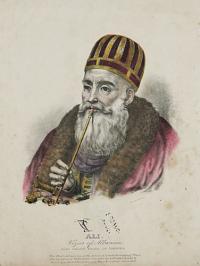
Ali, Vizier of Albanien, also called Pacha of Jannina. This Print forms one of the Series of Greek Portraits (4thPart) now in course of publication in London by A. Friedel, & Sold by the principal Book & Printsellers in Town & Country. June 1826.
Bouvier lithog.
Coloured lithograph. 'J. Whatman' Turkey Mill watermark. Printed area 270 x 190mm (10½ x 7½") Some spotting.
Ali Pasha (1740-1822), the Lion of Yannina, a Muslim Albanian ruler who served as an Ottoman pasha of the western part of Rumelia, the Ottoman Empire's European territory. A cruel ruler, he set about creating an almost-independent Greek-speaking state, allying himself with Napoleon, the British and whoever would serve him best. He eventually irked Sultan Mahmud II enough to send an army to bring him back under Ottoman control. Accepting the offer of a pardon he retired to a monastery, but soldiers were sent to arrest him for execution. Aged 82 he died fighting, shot through the floor of his room then beheaded.
[Ref: 41975] £190.00
(£228.00 incl.VAT)
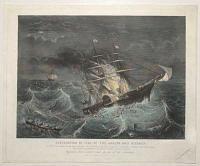
Destruction by Fire of the Amazon Mail Steamer. of 2250 Tons burden, in the Bay of Biscay, Jan.y 4th 1852, on Her first voyage from Southampton to Chagres, with 50 Passsengers and 106 Crew and attendants, the greater number of whom were lost.
Engraved from a sketch made by one of the Survivors.
Read & Co., 10, Johnson's Court, Fleet St. London [n.d., c.1852].
Rare steel engraving with hand colour. 265 x 330mm (10½ x 13"). Trimmed close to plate, slight scuffing in inscription area.
RMS Amazon was a wooden barque with three masts and a paddle wheel, launched in 1851. On her maiden voyage the bearings on her two side-lever steam engines kept overheating, which possibly led to a fire in the hay bales kept for animal feed. The order to abandon ship was given, but heavy seas swamped most of the boats launched. The brig 'Marsden', seen in the background, rescued 21 people from a lifeboat, at one stage believed to be the only survivors but, over the course of the next few days, two other boats were recovered. It is estimated that over two-thirds of the passengers and crew died. At the time the Admiralty supervised UK merchant ships contracted to carry mail, demanding that they all have wooden hulls. After the Amazon disaster this order was rescinded, so iron hulls became the norm.
[Ref: 56510] £360.00
![[Peace of Amiens] Old Times Returned.](img-thumbnail/jpegs/63119.jpg)
[Peace of Amiens] Old Times Returned.
W. f. [George Moutard Woodward.]
Pub.d May 18 1802 by S.W. Fores 50 Piccadilly. Folios of caracatures lent out for the Evening.
Coloured etching. Sheet 260 x 360mm (10¼ x 14¼"). Trimmed within plate, title slightly cropped.
An obese John Bull eats at a laden table; The waiter says ''Pudding did you say Sir?''; Bull retorts angrily ''Yes you Scoundrel Pudding_ do you mean to stave a Man in a Christian Country _ at Peace with all the World!''. The Treaty of Amiens was signed on 25th March 1802, resulting in a pause in the war with Revolutionary France until 18th May 1803.
[Ref: 63119] £240.00
(£288.00 incl.VAT)
![L'Amour en Ribote [The Drunken Cupid; in image, to banner cartouche upper left.]](img-thumbnail/jpegs/17714.jpg)
L'Amour en Ribote [The Drunken Cupid; in image, to banner cartouche upper left.]
['peint par Eisen Père - Gravé par L. Halbou.]
[A Paris chés Basan Graveur n.d., c.1760.]
Rare engraving, proof before letters, sheet 455 x 335mm. 18 x 13¼". Trimmed to plate.
This scene was painted with a companion "Les dragons de Vénus". Three figures framed by a carved masonry or wooden border. A latter-day cupid, a portly young male with bow and quiver of arrows over his shoulder perched on the lintel, talks to two young ladies, earnestly entreating them for more wine from the bottle that one lady holds. This cupid seems already somewhat inebriated, and the woman holds the bottle away from his outstretched hand, while he holds up an empty glass in his left hand. A potted vine laden with grapes grows against the left side of the frame, while an arrow pierces a heart lower right. Painted by François Eisen, engraved by Louis Michel Halbou and published by Pierre François Basan, this appears to be a rare engraving: according to their website catalogue the Bibliothèque nationale de France hold only a photomechanical reproduction of this image. See La BNF: FRBNF40914125.
[Ref: 17714] £480.00
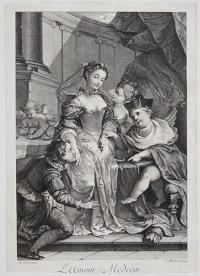
L'Amour Medecin.
Jac. Courtin pinx. C. Mathey Sculp.
[n.d. c.1770.] [AParis chez Mr. Surugue ruë des Noyens vis á vis S. Yves et chez l’Auteur avec Priv. du Roy.]
Engraving, scarce. 355 x 255mm. 14 x 10". Cut.
A romantic medical print. Cupid disguised as a doctor treating love between a young man on his knees pleading with a young maiden standing by a table; Cupid's arrows under his chair, another winged putto over by a column drawing.
[Ref: 26538] £390.00

Anger.
Designed etched & published Decr. 1st. by S. Howitt, Panton Street, Haymarket, London. [c.1802.]
Rare hand coloured etching and aquatint, 260 x 315mm. 10¼ x 12½".
An angry black stallion chasing a dog in a field; a shooter and another dog retreating towards a gate in the background. A fine aquatint by Samuel Howitt (1756 - 1822), for a series of (four?) 'attitudes' of horses, possibly republished by R. Hixon in 1809. See Siltzer pp. 163-164.
[Ref: 19461] £140.00
(£168.00 incl.VAT)
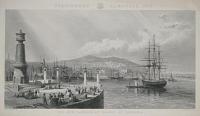
The New Harbour Of Refuge At Holyhead.
Drawn by P. Phillips. Engraved by H. Adlard.
Stationers' Almanack, 1858.
Steel engraving, sheet 265 x 455mm. 10½ x 18". Trimmed within plate.
Holyhead is the largest town in the county of Anglesey in the north west of Wales. Holyhead's maritime importance was at its height in the 19th century when the two and a half mile breakwater, widely acknowledged to be one of Britain's finest, was built, creating a safe harbour for vessels caught in stormy waters on their way to Liverpool and the industrial ports of Lancashire. Engraved for the Stationers' Almanack. The Stationers' Company had published the Stationers' Almanack since 1747, a single-sheet which consisted of calendar text set out beneath an engraved headpiece that recorded significant events of the preceeding year.
[Ref: 9986] £180.00
(£216.00 incl.VAT)
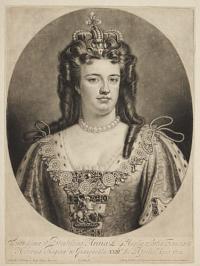
Serenissima et Potentissima Anna D.G. Angliæ Scotiæ Franciæ et Hiberniæ Regina &c. Inaugurata XXIII.o die Aprilis Anno 1702.
G. Kneller S.R. Imp. et Angl. Eques. Aur. pinx. I. Smith fec.
Sold by I. Smith at ye Lyon & Crown in Russel-street Covent-Garden. [n.d. c.1740.]
Fine mezzotint, with small margins. 340 x 250mm (13¼ x 9¾"). Mounted in album paper.
Portrait of Queen Anne 1665-1714), half-length in an oval, wearing small crown, pearl necklace, ermine-lined robes with jewels, with the 'Great George' of the Order of the Garter. In 1707 Anne signed the Act of Union, creating the Kingdom of Great Britain; here England and Scotland are still separate kingdoms. CS: 7, state ii of iii. Ex: Collection of the Hon. Christopher Lennox-Boyd.
[Ref: 34367] £240.00
(£288.00 incl.VAT)
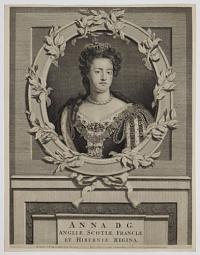
Anna D.G. Angliae, Scotiae, Franciae et Hiberniae Regina.
G. Kneller S.R. Imp. et Angl. Eques. Aur. pinx. Petrus a Gunst sculps et excudit tot Amsterdam, op de binnen Amstel, op de hoek van de Kyfen graft [c.1700]
Rare engraving, sheet 355 x 270mm (14 x 10½"). Trimmed inside platemark and glued to backing sheet.
Portrait of Queen Anne (1665-1714), half-length in an oval, wearing small crown, pearl necklace, ermine-lined robes with jewels. In 1707 Anne signed the Act of Union, creating the Kingdom of Great Britain; here England and Scotland are still separate kingdoms. Her support of the union contributed significantly to its acceptance by both kingdoms, while her staunch support of the duke of Marlborough in the face of opposition made it possible for him to use his skills to re-establish the balance of power in Europe. Engraved and published after Kneller's portrait, by the Amsterdam-based printmaker Pieter van Gunst. Not in O'D.
[Ref: 39750] £160.00
(£192.00 incl.VAT)
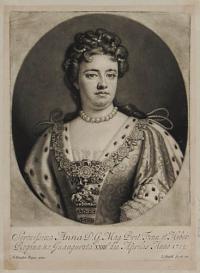
Serenissima Anna D.G. Mag. Brit. Fran. et Hiber. Regina &c. Inaugurata XXIII.o die Aprilis Anno 1702.
G. Kneller Eques pinx. I. Smith fe. et ex.
[n.d. c.1740.]
Mezzotint, mounted on album paper (Whatman 1804). 205 x 150mm (9¾ x 6").
Half-length portrait of Queen Anne (1665-1714), in an oval, wearing the 'Great George' of the Order of the Garter. The second daughter of James II and successor to William III, the most important constitutional landmark of her reign was the Act of Union with Scotland in 1707, creating the Great Britain of the title. CS: 6, state i of ii.. Ex Collection of the Hon. Christopher Lennox-Boyd.
[Ref: 34363] £180.00
(£216.00 incl.VAT)
![[Apocrypha Combatants. Being a Series of Twelve Caricatures, Illustrative of that Controversy.]](img-thumbnail/jpegs/18281.jpg)
[Apocrypha Combatants. Being a Series of Twelve Caricatures, Illustrative of that Controversy.]
[Published by Thomas Sinclair, West Regester Street Edinburgh, n.d., 1828.]
Oblong quarto, original card covers, stitched, ink mss. title, rubbed; 16 lithographs (5 with old colour) from the two 'Apocrypha Combatants' series (1-5, 8-12 of the First Series, 1-6 of the second series; and six further lithographs in the same style. Lacking title sheets. Scarce collection. Some wear, one of the extra plates with a tear into image.
A scarce series of caricatures satirising the controversy over which of the Apocrypha should be included in the bible. Andrew Mitchell Thomson (1779–1831) resigned from the British and Foreign Bible Society in 1824, on the grounds that they had bound up the Apocrypha with the Bible. He used his ‘Christian Instructor’ to condemn them, creating this controversy, lasting until 1836. Apocrypha means 'hidden things' in Greek. The Apocryphical books of the Bible fall into two categories: texts which were included in some canonical version of the Bible at some point, and other texts of a Biblical nature which have never been canonical. Thomas Sinclair (1805-81), born in the Orkney Isles, studied lithography in Edinburgh. He had emigrated to Philadelphia by 1833, where he worked for Kennedy & Lucas before setting up his own firm in 1838. He was one of the first printers in Philadelphia to experiment with colour lithography. See BM Satire: 15573, etc. As the BM only has 1-6 of the second series it is unlikely more were published (they have only a photostat of plate 2.)
[Ref: 18281] £950.00
view all images for this item
![[Archangels.] Michael.](img-thumbnail/jpegs/51890.jpg)
[Archangels.] Michael. Militiæ princeps coelestis Sæua Michael Cum diro invictus bella dracone gerit. C. Kil. Duffl.
M. de Vos invent. Crisp. van der Pas sculp.
Phl's Galle excud. [n.d. c.1590.]
Rare engraving. 160 x 90mm (6¼ x 3½"), with large margins.
The Archangel Michael, standing with cross in hand. Behind is a scene of him defeating the dragon. Plate 2 of a series of nine portraits of the Archangels engraved by Crispijn de Passe the Elder (1564-1637) after Maarten de Vos (1532 - 1603). The author of the verse was Cornelis Kiliaan (1528-1607) of Duffel, poet and lexicographer, author of an important Dutch-Latin dictionary, 'Dictionarium Teutonico-Latinum', 1574. BM: 1868,0612.2027. The BM does not list the full set.
[Ref: 51890] £190.00
(£228.00 incl.VAT)
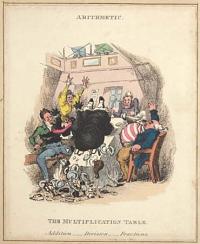
Arithmetic. The Multiplication Table. Addition _ Division _ Fractions.
[Drawn and engraved by William Heath.]
[n.d., c.1820.]
Coloured etching. Sheet 215 x 180mm (8½ x 11"). Trimmed and laid on album paper.
A large woman falls from a gallery onto a dining table, scattering the fare. One from a series of satires on educational subjects.
[Ref: 54314] £220.00
(£264.00 incl.VAT)

Eglise des Armeniens.
[Amsterdam: J.F. Bernard c.1736.]
Engraving. 340 x 220mm, 13½ x 8¾".
The interior of an Armenian church, published in Jean Frederic Bernard's monumental "Cérémonies et coutumes religieuses de tous les peuples du monde" (Religious Ceremonies and Customs of All the Peoples of the World). 'The world's first encyclopedia of religions, the heavily illustrated, detailed general survey treating all religions dispassionately and as notionally equal, was composed and published in Amsterdam under the title 'Cérémonies et coutumes religieuses de tous les peuples du monde' in seven large volumes between 1723 and 1737 by a group of radical, intellectually subversive Huguenot refugees' (Jonathan Israel, 'How the light came in', TLS June 21 2013).
[Ref: 15881] £70.00
(£84.00 incl.VAT)

Shakespeare's Seven Ages of Man Illustrated.
Drawn by Tho.s Stothard Esq. R.A. Engraved by Will.m Bromley.
Publish'd Jan.y 24 1799 by W. Bromley, Jessamine House, Hammersmith.
Folio (455 x 305mm, 18 x 12"), original boards; stipple engraved title, engraved text sheet & 7 stipple plates, all printed in sepia; complete with very large margins. Binding distressed, plates with spotting and damp stain.
The complete set of plates illustrating Jaques's monologue in William Shakespeare's 'As You Like It', reproduced on the engraved text sheet. The title features two cherubs, one young, the other with a crutch, and an ouroboros (a snake eating its own tail). The plates are: 'Infant', 'School Boy', 'Lover', 'Soldier', 'Justice', 'Pantaloon' and 'Childishness'.
[Ref: 56479] £680.00
view all images for this item

General Sir Charles Asgill Bar.t G.C.G.O. &c. &c. &c.
Painted by T. Philips Esq.r. Engraved by C. Turner.
London Published April 20th 1822, by C. Turner No 55. Warren Street, Fitzroy Square.
Mezzotint. 505 x 355mm (20 x 13¾"), with very large margins. Paper toned, edges brittle.
Half-length portrait of Charles Asgill (1762-1823) in his dress uniform. Asgill found fame when, having being taken prisoner at the surrender at Yorktown, he was sentenced to death by George Washington in retaliation for the death of an American captain at Loyalist hands. Asgill's mother appealed to Louis XVI, who sent an ambassador who successfully requested a reprieve. Asgill later wrote a letter to an American newspaper detailing the treatment he received in captivity, including beatings by drunken revellers who had paid money to enter his cell.
[Ref: 50091] £280.00
(£336.00 incl.VAT)
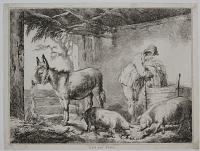
Ass and Pigs.
[After Morland], Vivares fecit.
Published & Sold by Edwd. Orme, 39 New Bond Street July 1, 1804.
Soft-ground etching. 342 x 455mm. 13½ x 18". Cut.
In a stable a farm-hand fills a manger with straw at right, two pigs eating in the foreground, an ass standing at the door at left, also eating. Abbey Life: 208.3.
[Ref: 25007] £160.00
(£192.00 incl.VAT)

Penitences Mexicaines. Sacrifice des Captifs.
B. Picart, del. Tom VII. No. 18.
[Paris: Antoine Laporte, c.1789.]
Copper engraving. Bookplate. Plate 341 x 221mm. Sheet 390 x 252mm. Some spots of staining in the upper part of the image.
Two scenes. 1. Mexican penitences. Before the Gods, Mexicans punish themselves for sinning, whilst musicians accompany their pains with music of the Gods. 2. Sacrifice of the Captives. High Priests at the altar of the Gods sacrifice prisoners as an offering to please the Gods. Published in Jean Frederic Bernard's monumental "Cérémonies et coutumes religieuses de tous les peuples du monde" (Religious Ceremonies and Customs of All the Peoples of the World). 'The world's first encyclopedia of religions, the heavily illustrated, detailed general survey treating all religions dispassionately and as notionally equal, was composed and published in Amsterdam under the title 'Cérémonies et coutumes religieuses de tous les peuples du monde' in seven large volumes between 1723 and 1737 by a group of radical, intellectually subversive Huguenot refugees' (Jonathan Israel, 'How the light came in', TLS June 21 2013).
[Ref: 12503] £65.00
(£78.00 incl.VAT)

Bachelors Hall. 609.
[after Robert Dighton.]
Printed for & Sold by Carington Bowles, No. 69 St. Paul's Church Yard, London. Published as the Act directs, 24 June, 1791.
Mezzotint with hand colour. 355 x 250mm (14 x 10") very large margins.
Men in riding garb eating and drinking around a table, a parson drinking near the window. On the wall is a rack of guns and ramrods.
[Ref: 51825] £380.00
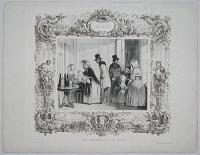
Le Patissier a la Mode.
C. Malapeauy. Im.de Lemercier et C.ie.
Bourdet Jeune, éditeur. à Paris chez Dupin, Galerie Colbert. [n.d. c.1850.]
Lithograph. 279 x 356mm. 11 x 14". Spotting.
Inside a pâtisserie in Paris; a woman sat behind a counter with pastries and sweets on, speaking to a female customer who is paying for her goods, a gentleman admires the display, and a family of three standing looking at the cakes on the shelves to the right. A table in the near left foreground holds various bottles of liqueur.
[Ref: 22873] £65.00
(£78.00 incl.VAT)
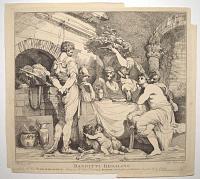
Banditti Regaling To the R.t Hon.ble Earl Harcourt, this Etching from the Original Drawing by Mortimer in the possession of S. Ireland is inscribed By his Lordships much obliged & obedient Serv.t S. I.
Mortimer Del.t Sam. Ireland fecit.
1785.
Etching. 430 x 465mm (17 x 18¼"). Torn along plate edge upper right corner and lower left corner and edge. One small tear affects the title area. Small margins.
A group of bandits feasting and relaxing in a courtyard. The inscription is likely dedicated to George Harcourt (1736-1809), who was a politician and noted patron of the arts.
[Ref: 53968] £260.00
(£312.00 incl.VAT)
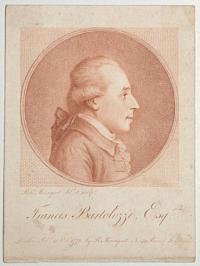
Francis Bartolozzi Esq.r
Rob.t Menageot, del.t et sculp.t
London, Pub.d 12, Oct.r 1778, by R. Menageot, No.49 Broad Street, Soho.
Stipple printed in red. 152 x 114mm (6 x 4½").
Francesco Bartolozzi (1725-1815), Florentine engraver who was elected a founding member of the Royal Academy in 1768 (the RA did not admit engravers at this time but made an exception in his case). Bartolozzi lived and worked in London for nearly 40 years creating a huge number of stipple engravings throughout his career. Shortly after his arrival in London Bartolozzi was appointed as 'Engraver to the King'. See Ref: 35725 for same image printed in colour.
[Ref: 52441] £180.00
(£216.00 incl.VAT)
Unfortunately this item is either sold or reserved. If you are interested in similar items and cannot find what you're looking for on our website, please consider filling in our interests form. If you register, we can also send you items that match your interests when the website is updated.
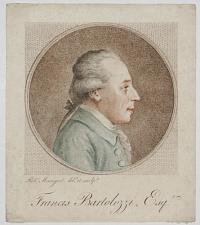
Francis Bartolozzi, Esq.r.
Rob.t. Menageot del.t. et sculp.t.
[n.d., c.1778.]
Stipple printed in colour, rare. Sheet: 115 x 135mm (4½ x 5¼"). Trimmed within plate and publication line.
A half portrait in profile, set in a roundel of Italian engraver Francesco Bartolozzi (1724-1815). Bartolozzi lived and worked in London for nearly 40 years creating a huge number of stipple engravings throughout his career. Shortly after his arrival in London Bartolozzi was appointed as 'Engraver to the King'. See also ref: 52441
[Ref: 35725] £120.00
(£144.00 incl.VAT)
Unfortunately this item is either sold or reserved. If you are interested in similar items and cannot find what you're looking for on our website, please consider filling in our interests form. If you register, we can also send you items that match your interests when the website is updated.
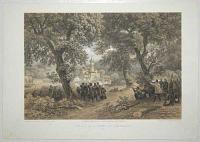
Attack of the S Fermo By Garibaldi. 33.
Carlo Bossoli, del.t _ T. Picken, lith. Day & Son, Lith.rs to the Queen.
Publsihed by Day & Son, Lithographers to the Queen.
Lithograph, sheet 195 x 280mm (7¾ x 11).
A view of the Hunters of the Alps', led by Giuseppe Maria Garibaldi (1807–1882), attack on the church of San Fermo where the Austrian force were taking up a defensive position during the Battle of San Fermo (27 May 1859) during the Second Italian War of Independence. Garibaldi's troops fire at the church within the cover of trees, creating gun smoke. Carlo Bossoli (1815-84) made his name with his paintings of the Crimea, made 1828-43, which became fashionable when the Crimean War started in 1854.
[Ref: 56582] £85.00
(£102.00 incl.VAT)

Napoleon Defeating the Mamelukes, at the Battle of the Pyramids, near Cairo.
Engrav'd by Mr George Cruikshank from the Design of Swebach, originally Published at Paris, and dedicated to the Grand Army.
Published October 1 1823 by John Cumberland, No 19, Ludgate Hill.
Coloured aquatint, J. Whatman, Turkey Mill 1827 watermark. Sheet 215 x 295mm (8½ x 11½"). Folded twice as issued, trimmed close to image, small split taped, album paper stuck over left edge.
In the Battle of the Pyramids (or Battle of Embabeh), 21st July 1798, Napoleon destroyed the Ottoman armies of Egypt, using a new tactic, the Divisional Square, to counter the Mameluck cavalry attacks. From W.H. Ireland's 'Life of Napoleon Bonaparte', 1828. Tooley 278.
[Ref: 54170] £65.00
(£78.00 incl.VAT)
![[The Bean King.]](img-thumbnail/jpegs/35573.jpg)
[The Bean King.] Jüng gewohnt alt gethan. Adeo a teneris assuescere, multum est.
Jordans inv.
Joh. Elias Ridinger excud. aug. Vind. [n.d, c.1720.]
Mezzotint. Sheet 425 x 535mm (16¾ x 21"). Trimmed to image.
A mezzotint based on one of the four paintings by Jacob Jordaens (1593-1678) of 'The Bean King'. The subject is a 'bean feast', a traditional Dutch feast held on January 6, the day that the Three Kings or Magi came to worship the Christ Child. A pie or cake containing a bean was baked for the festivities and he who found the bean in his piece of pie or cake became Bean King. Ex: Collection of the Hon. Christopher Lennox-Boyd.
[Ref: 35573] £440.00
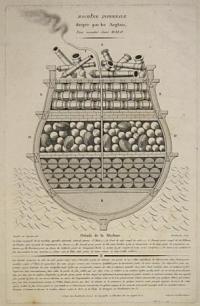
Machine Infernale dirigee par les Anglais, Pour incendier Saint Malo. ['Details de la Machine' key lettering below image, brief history of use of incendary ships by the English below that.]
Beauble nee Gipoulou, del. Beauble fils. Sculp.
A Paris chez Beauble fils, Graveur de Geographie et d'Ecriture, Rue des Anglais, N.8. [n.d., c.1805.] Depose a la Bibliotheque.
Engraved plan in the form of a cross-section of a ship's hull, 308 x 199mm. Some creasing and soiling to margins.
A French explanation of the English innovation of cramming unmanned merchant ships with incendiaries, used to destroy harbour defences. Admiral John Benbow arrived off St. Malo, a walled port city in Brittany, in the middle of November 1693 and immediately started firing mortars over the wall in to the town and among the sheltering French ships. This continued for three days and on the fourth night he prepared to send in the first Infernal ever used by the Royal Navy. Benbow intended to manoeuvre the barque under the town's sea wall but it struck a rock and the engineers were forced to light the fuses and row for their lives. The vessel burned for some time but eventually blew up. The force of the explosion rocked the town like an earthquake. It blew the roofs off three hundred houses and broke all the glass and earthenware for miles around. The capstan, which weighed two hundred pounds, flew in to the air and, when it landed, completely levelled a house. Large parts of the sea wall collapsed. If Benbow had had a force of Marines he would undoubtedly have been able to take the town. He was given the task of repeating his success at Dunkirk but the Infernal proved less effective and the Admiralty dropped their use.
[Ref: 7707] £230.00
(£276.00 incl.VAT)
![[Henry Somerset, first Duke of Beaufort - coat of arms].](img-thumbnail/jpegs/10867.jpg)
[Henry Somerset, first Duke of Beaufort - coat of arms].
Guil: Faithorne del: et sculp:
Engraving 276 x 201mm. 10¾ x 8¼inches. Trimmed on plate minor all over foxing.
Henry Somerset, Marquess of Worcester, [1629-1700] became the First Duke of Beaufort in 1682. Styled as Lord Herbert from 1646 until 1667, he survived the tumultuous and uncertain decades that followed the English civil war by creating remarkable political alliances. While sitting in the Cromwellian Parliament he maintained good relations with the Lord Protector. He was sent to the Tower in 1659 for his part in a Royalist plot and by 1660 was advocating the Restoration. He worked to restore his family’s estates and political power base. He also sought to tame political and religious passions and to bring order and stability. Henry, third marquis of Worcester and first duke of Beaufort, was a powerful regional magnate and became an active member of Charles II’s Privy Council. He refused to swear allegiance to William of Orange. Fagan:p.21 only state.
[Ref: 10867] £240.00
(£288.00 incl.VAT)
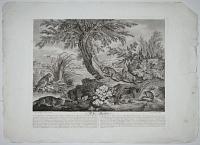
The Beaver.
J.E. Ridinger at viv. del. J.S. Muller Sculpt.
[British, n.d., c.1780.]
Etching, 340 x 415mm. 13½ x 16¼". Tatty extremities.
Landscape with six beavers, one of them in the centre eating the bark of a tree. Extensive description below title. Numbered '10' lower and upper right. After Johann Elias Ridinger (1698 - 1767) from an English publication of the c.1736 series of natural history and hunting subjects 'Betrachtung der wilden Thiere mit beygefügter vortrefflicher Poesie des hochberühmten Herrn Barthold Heinrich Brockes'.
[Ref: 20558] £220.00
(£264.00 incl.VAT)

Benedicite Benisé la bonté Supréme / Mes Enfans avant le repas / C'est le Seigneur nen doutez pas / Qui nous nourit luy meme
le Brun in. C. Duflos ex
AParis Chez Duflos rue S. Jacques [c.1720]
Engraving, platemark 120 x 155mm (4¾ x 6"). Very large margins.
Family saying grace before a meal., after Charles Le Brun (1619-90).
[Ref: 37105] £65.00
(£78.00 incl.VAT)
![[Gian Lorenzo Bernini] Beninus Pictor, sculptor et Architectus.](img-thumbnail/jpegs/62285.jpg)
[Gian Lorenzo Bernini] Beninus Pictor, sculptor et Architectus.
Salvator Rosa, del.t. J. Basire sc.t. 1764.
[London: Printed by J. Nichols and sold by J. Boydell, 1778.]
Etching. 305 x 245mm (12 x 9¾"). Mounted in album paper at edges, small hole filled.
A bust portrait of Gian Lorenzo (or Gianlorenzo) Bernini (1598-1680), sculptor and architect, credited with creating the Baroque style of sculpture. From 'Prints in Imitation of Drawings' by Charles Rogers.
[Ref: 62285] £140.00
(£168.00 incl.VAT)
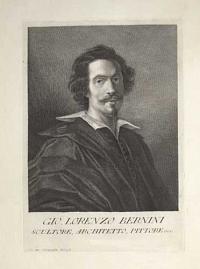
Gio. Lorenzo Bernini Scultore, Archietto, Pittore ecc.
Gio. Do. Campiglia del. e sc.
[n.d., c.1766.]
Fine engraving. 265 x 190mm (10½ x 7½"), with very large margins.
A half-length portrait of Gian Lorenzo (or Gianlorenzo) Bernini (1598-1680), sculptor and architect, credited with creating the Baroque style of sculpture. This portrait was part of A. F. Gori's monumental 'Museum Florentium', which set out to engrave all the portraits of painters, architects, sculptors and patrons of the arts in the major galleries of Florence. This vast undertaking was issued in parts, taking over thirty years (1731-1766) to complete. In this case, the intermediate artist and engraver was Giovanni Domenico Campiglia (1692-1768)
[Ref: 59698] £170.00
(£204.00 incl.VAT)

Blindmans Buff.
London, Published as the Act directs by S. Fryett, 41, Banner Street, St. Lukes.
Hand coloured aquatint with etching. On watermarked paper, 'J. Whatman. 1826.' Platemark: 350 x 470mm (13¾ x 18¼"). Repaired tear in lower right corner. Small tear in upper edge.
A vibrant scene with a group playing a game of blind man's buff outside a cottage, in the clearing of a wooded area. The blindfolded figure is seen in the centre, with a number of people surrounding him, with one young woman crouching behind him, so not to be caught. In the foreground to the right, two men are seen eating and drinking, gesturing towards the game. In the lower left, a dog chews a piece of meat on the floor.
[Ref: 36663] £490.00
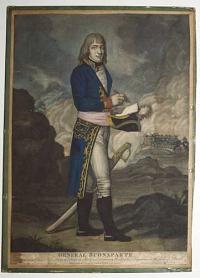
General Buonaparte. Commander in Chief of the French Army in Italy and Germany, Writing his Dispatches in the field of Battle. (Taken from the Original Portrait Publish'd at Paris.)
[After Hilaire Ledru.]
Publish'd May 14th 1797 [by *] Thompson No 50 Old Bailey and J. Evans No 42 Long Lane, West Smithfield.
Mezzotint with fine hand colour. Verso: Keatings Powder kills bugs, fleas & moths Advert; Sheet 350 x 250mm. Trimmed image on three sides, some scuffing, laid on board. Damaged.
A rare portrait of Napoleon as a general of the Republican army, shown full-length with paper and pencil in his hand. Behind a battle rages, probably representing the battle at the bridge at Arcole (1796).
[Ref: 58535] £260.00
(£312.00 incl.VAT)
![[Two lovers in an elegant bedroom]](img-thumbnail/jpegs/54602.jpg)
[Two lovers in an elegant bedroom]
[after Jean Baptiste Pater.]
[n.d., c.1740.]
Engraving, proof before all letters. Sheet 295 x 380 (11½ x 15"). Trimmed within plate. Foxing.
The woman sits on the end of the bed, drawing the man to her, while he gestures at a cat and a dog that pick off the remains of their meal.
[Ref: 54602] £260.00
(£312.00 incl.VAT)
![[The Breakfast Table.]](img-thumbnail/jpegs/56664.jpg)
[The Breakfast Table.]
D. Wilkie R.A. Etched by C.W. Marr.
London, Nov. 24, 1823, Published by J. Young, Upper Charlotte Street, Fitzroy Square, and Hurst, Robinson & Co 90 Cheapside.
Etchin on chine collé. 290 x 230mm (11½ x 9"), very large margins.
An etching after David Wilkie's painting 'The Breakfast Table', with an old couple and a young man sitting at a round breakfast table. A maid pours hot water into a teapot.
[Ref: 56664] £70.00
(£84.00 incl.VAT)
![Breakfast. Symptons of Drowsiness. [&] Dinner. Symptoms of Eating and Drinking.](img-thumbnail/jpegs/54540.jpg)
Breakfast. Symptons of Drowsiness. [&] Dinner. Symptoms of Eating and Drinking.
H. Bunbury Esq.r Delin.t. W. Dickinson Execudit.
Published April 21, 1803 by Jn.o Harris No.3 Sweetings Alley, Cornhill, & 8 Old Broad Street, London.
Pair of stipples. 350 x 450mm (13¾ x 17¾") very wide margins left & right (marginal tears). 'Breakfast' trimmed to plate at top, 'Dinner' with loss of margin to plate at bottom.
The 'Breakfast' shows sportsmen in a bare breakfast parlour; the 'Dinner' shows five men and two ladies seated at a more opulent dinner-table. These plates would have been originally published by Dickinson in the 1780s. See BM Satires 8537 & 8538 for 1794 editions.
[Ref: 54540] £480.00
view all images for this item
![[Journée du XIII Vendémiaire, L'an IV. Eglise St. Roch, rue St. Honoré.]](img-thumbnail/jpegs/36163.jpg)

![[Designs of different pieces of furniture done for this House.]](img-thumbnail/jpegs/27740.jpg)
![[Various Clocks & Pieces of Ornamental Furniture.]](img-thumbnail/jpegs/27739.jpg)

![[The Aeolinan]](img-thumbnail/jpegs/62245.jpg)
![[Life of Aesop: Aesop convicting his fellow servants of having eaten the figs.]](img-thumbnail/jpegs/48708.jpg)
![[The Satyr and the Peasant.] Iste frigus & ardorem [...]](img-thumbnail/jpegs/57441.jpg)
![[The Satyr and the Peasant.]](img-thumbnail/jpegs/57789.jpg)



![[Alexander the Great pardons the family of Darius]](img-thumbnail/jpegs/45146.jpg)


![[Peace of Amiens] Old Times Returned.](img-thumbnail/jpegs/63119.jpg)
![L'Amour en Ribote [The Drunken Cupid; in image, to banner cartouche upper left.]](img-thumbnail/jpegs/17714.jpg)






![[Apocrypha Combatants. Being a Series of Twelve Caricatures, Illustrative of that Controversy.]](img-thumbnail/jpegs/18281.jpg)
![[Archangels.] Michael.](img-thumbnail/jpegs/51890.jpg)













![[The Bean King.]](img-thumbnail/jpegs/35573.jpg)

![[Henry Somerset, first Duke of Beaufort - coat of arms].](img-thumbnail/jpegs/10867.jpg)


![[Gian Lorenzo Bernini] Beninus Pictor, sculptor et Architectus.](img-thumbnail/jpegs/62285.jpg)



![[Two lovers in an elegant bedroom]](img-thumbnail/jpegs/54602.jpg)
![[The Breakfast Table.]](img-thumbnail/jpegs/56664.jpg)
![Breakfast. Symptons of Drowsiness. [&] Dinner. Symptoms of Eating and Drinking.](img-thumbnail/jpegs/54540.jpg)